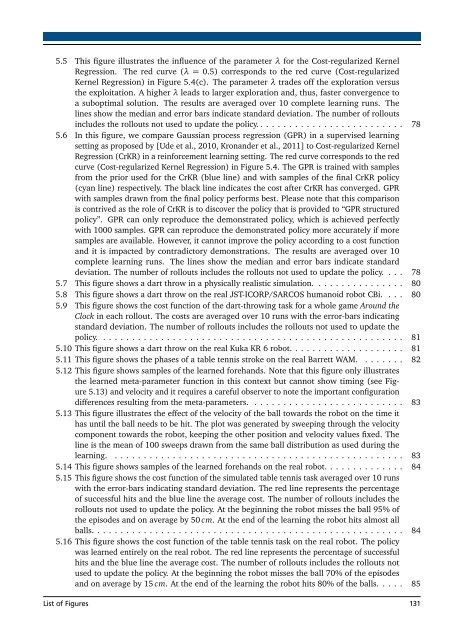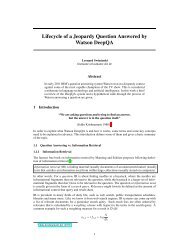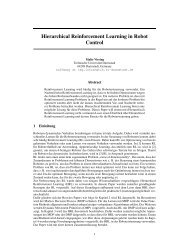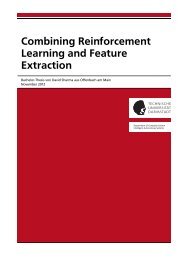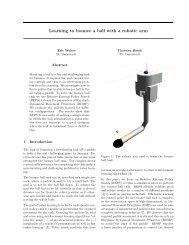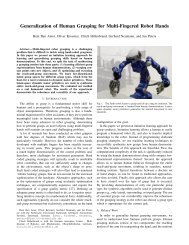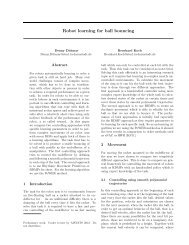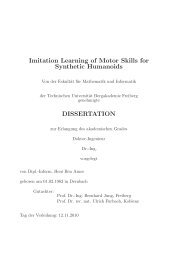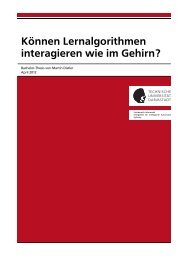Learning Motor Skills - Intelligent Autonomous Systems
Learning Motor Skills - Intelligent Autonomous Systems
Learning Motor Skills - Intelligent Autonomous Systems
You also want an ePaper? Increase the reach of your titles
YUMPU automatically turns print PDFs into web optimized ePapers that Google loves.
5.5 This figure illustrates the influence of the parameter λ for the Cost-regularized Kernel<br />
Regression. The red curve (λ = 0.5) corresponds to the red curve (Cost-regularized<br />
Kernel Regression) in Figure 5.4(c). The parameter λ trades off the exploration versus<br />
the exploitation. A higher λ leads to larger exploration and, thus, faster convergence to<br />
a suboptimal solution. The results are averaged over 10 complete learning runs. The<br />
lines show the median and error bars indicate standard deviation. The number of rollouts<br />
includes the rollouts not used to update the policy. . . . . . . . . . . . . . . . . . . . . . . . . . 78<br />
5.6 In this figure, we compare Gaussian process regression (GPR) in a supervised learning<br />
setting as proposed by [Ude et al., 2010, Kronander et al., 2011] to Cost-regularized Kernel<br />
Regression (CrKR) in a reinforcement learning setting. The red curve corresponds to the red<br />
curve (Cost-regularized Kernel Regression) in Figure 5.4. The GPR is trained with samples<br />
from the prior used for the CrKR (blue line) and with samples of the final CrKR policy<br />
(cyan line) respectively. The black line indicates the cost after CrKR has converged. GPR<br />
with samples drawn from the final policy performs best. Please note that this comparison<br />
is contrived as the role of CrKR is to discover the policy that is provided to “GPR structured<br />
policy”. GPR can only reproduce the demonstrated policy, which is achieved perfectly<br />
with 1000 samples. GPR can reproduce the demonstrated policy more accurately if more<br />
samples are available. However, it cannot improve the policy according to a cost function<br />
and it is impacted by contradictory demonstrations. The results are averaged over 10<br />
complete learning runs. The lines show the median and error bars indicate standard<br />
deviation. The number of rollouts includes the rollouts not used to update the policy. . . . 78<br />
5.7 This figure shows a dart throw in a physically realistic simulation. . . . . . . . . . . . . . . . 80<br />
5.8 This figure shows a dart throw on the real JST-ICORP/SARCOS humanoid robot CBi. . . . 80<br />
5.9 This figure shows the cost function of the dart-throwing task for a whole game Around the<br />
Clock in each rollout. The costs are averaged over 10 runs with the error-bars indicating<br />
standard deviation. The number of rollouts includes the rollouts not used to update the<br />
policy. . . . . . . . . . . . . . . . . . . . . . . . . . . . . . . . . . . . . . . . . . . . . . . . . . . . . 81<br />
5.10 This figure shows a dart throw on the real Kuka KR 6 robot. . . . . . . . . . . . . . . . . . . . 81<br />
5.11 This figure shows the phases of a table tennis stroke on the real Barrett WAM. . . . . . . . 82<br />
5.12 This figure shows samples of the learned forehands. Note that this figure only illustrates<br />
the learned meta-parameter function in this context but cannot show timing (see Figure<br />
5.13) and velocity and it requires a careful observer to note the important configuration<br />
differences resulting from the meta-parameters. . . . . . . . . . . . . . . . . . . . . . . . . . . 83<br />
5.13 This figure illustrates the effect of the velocity of the ball towards the robot on the time it<br />
has until the ball needs to be hit. The plot was generated by sweeping through the velocity<br />
component towards the robot, keeping the other position and velocity values fixed. The<br />
line is the mean of 100 sweeps drawn from the same ball distribution as used during the<br />
learning. . . . . . . . . . . . . . . . . . . . . . . . . . . . . . . . . . . . . . . . . . . . . . . . . . . 83<br />
5.14 This figure shows samples of the learned forehands on the real robot. . . . . . . . . . . . . . 84<br />
5.15 This figure shows the cost function of the simulated table tennis task averaged over 10 runs<br />
with the error-bars indicating standard deviation. The red line represents the percentage<br />
of successful hits and the blue line the average cost. The number of rollouts includes the<br />
rollouts not used to update the policy. At the beginning the robot misses the ball 95% of<br />
the episodes and on average by 50 cm. At the end of the learning the robot hits almost all<br />
balls. . . . . . . . . . . . . . . . . . . . . . . . . . . . . . . . . . . . . . . . . . . . . . . . . . . . . . 84<br />
5.16 This figure shows the cost function of the table tennis task on the real robot. The policy<br />
was learned entirely on the real robot. The red line represents the percentage of successful<br />
hits and the blue line the average cost. The number of rollouts includes the rollouts not<br />
used to update the policy. At the beginning the robot misses the ball 70% of the episodes<br />
and on average by 15 cm. At the end of the learning the robot hits 80% of the balls. . . . . 85<br />
List of Figures 131


